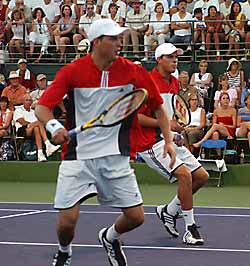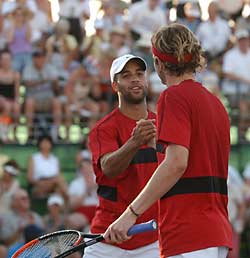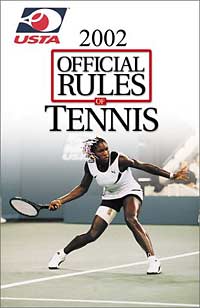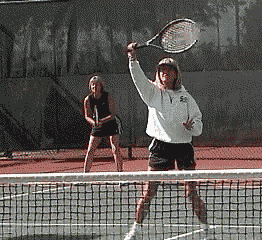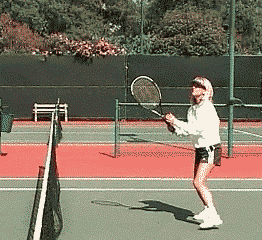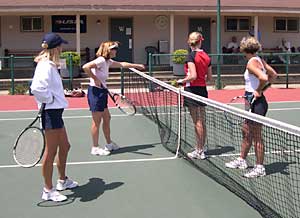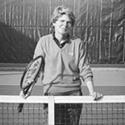|
TennisOne Lessons How to Become a Successful League Team By Pat Blaskower
When I first moved to Connecticut I was astounded by the numbers of students who, when I approached them about joining one of my USTA teams, would recoil and gasp "Never! Too much backbiting, politics and favoritism. Not worth it." Certainly that can be the case and one of the tragedies of a fledgling player being subjected to any of these problems is that he or she is probably soured on the experience permanently. Few things in sports are as devastating as innocent and excited expectations crushed by the insensitive or ill-informed behavior of a captain or coach. But careful preparation can produce an entire team of very happy and productive contributors. Define Success
First, and foremost, define successful. The moment the germ of the idea of forming a team enters your head, get your players together and have a meeting. If Beeper Marie joins your team believing that "successful" means she will play as many matches as Sukie, even though the sum total of her tennis playing experience does not include how to keep score in a tiebreak, you've got a problem. If Sukie joins your team with the assumption that she will play every match because she is (obviously) the best player on the team, that could be real trouble also. You must inquire of each prospective team member what his or her expectations are and then chart a very diplomatic course. You can avoid a myriad of potential problems down the road if, in this meeting, you ask the team to vote on whether they want to play "to win" or "to insure that each gets equal playing time." Too often team meetings are devoted to the thrill of starting a season together, the camaraderie, the team colors, and the team uniforms, thus failing to address this essential question. Coach or No Coach If you called the meeting, then you are probably going to be the Captain. The first and smartest thing you should do is get the team a good coach. A "good" coach should be someone who has literally "been there, done that." Hire someone who understands the nuances of being a league team coach - preferably, someone who has actually participated in USTA league play. When you find this jewel, let him or her set the practice schedules and make the lineups.
If your team has voted to "play to win," it really becomes a conflict of interest if the Captain both plays and makes lineups. You are just asking for dissension in your ranks. If, however, you have chosen to give everyone on your team equal playing team regardless of ability, you can more easily go "coachless." The main problem with that philosophy, though, is that your best players' interest in this endeavor will quickly wane. They will want to move to a more competitive environment. Once you have selected your coach, it becomes imperative that you, as Captain, work very closely with that expert and avoid becoming the "go-between" for your team members and the coach. If Beeper Marie is pouting because she has been omitted from the lineup this week, suggest that she should confront the coach. Never offer to speak to the coach on behalf of a player. If you do, here come "back-biting" and "favoritism " to spoil your budding success story. Do what you do best - promote the team, keep accurate records of how many times each teammate has played, report your scores, be a cheerleader, and leave the really hard decisions to the professional.
All "successful" teams, regardless of the definition, have a few things in common:
Finally, it takes about three years to develop a winning tradition, if that is what your team desires to build. Attrition will take care of those who are not up to the task, and those who are will grow and develop pride in their team and its past accomplishments. It is a worthy goal, and one requiring commitment and patience. When your reputation precedes you to the court, when your team name inspires awe and fear before you submit your lineup, you have arrived.
A Word on the Rules Of Engagement Now that you have your team together, your goals set, and your coach in place, make it a priority to know the rules of the game you play so you are never blind sided by an unpleasant situation that can interfere with your match. The following is a list of the ten most misunderstood, misinterpreted and overlooked rules in the game. Calling 'Out' Balls on Your Side There is a huge misconception that one partner cannot yell "out" on the doubles court when addressing his partner and imploring him not to hit the ball. I often have students tell me that when they have done so, their opponents have stopped play, thinking the "out" call signaled the end of the point. They then tell me that they must use "no" or "leave it" for fear of being misinterpreted by the opposition. WRONG! WRONG! WRONG! The rule states that you can say anything you want to your partner when the ball is traveling toward you, including "out," and it cannot be construed as addressing the other side of the net. The point is not over until you turn to your opponents and confirm to them that their shot was out, either verbally, by hand signal, or both. Interference Building upon the above information, when the ball is traveling away from you, you must be careful what you say. If you put up a short lob and then scream at the top of your lungs, "watch out partner, it's short..," you may be guilty of interfering with your opponents' ability to play the ball. If that is true, you lose the point. BUT, you opponent may not attempt to strike the ball and then claim interference. Here, the double chance rule would come into play. In order to claim interference, the player must make no attempt to play the ball. Speak quietly and let your racquet do the loud talking.
''Not-Ups' and Net-Touching Sometimes you are just positive your opponent played the ball on a double bounce, or perhaps touched the net. Finish the point and inquire about it later. These infractions can only be called by the offending player on himself, never by the opponent, so it is really best to assume nothing happened, win the point, and inquire at the conclusion of the point. If you thought you saw a double bounce, stopped play and your opponent denies the infraction, you are sunk. His point. The Net As an adjunct to the above, it is perfectly permissible to follow through across the net with your stroke as long as you started it on your side. The only exception is when the violent spin on the ball is about to take it back over to your opponent's side of the net without your being able to strike it. Then, you must reach across the net and touch the ball. Double Hits Double hits are perfectly legal so long as the stroke is one continuous motion. But again, the call must be made by the player striking the ball, so don't stop play to inquire. Service Line Calls Sometimes in doubles, the partners disagree about a service line call. The receiver's partner may call a fault, but the receiver plays the ball thinking the serve was good. In that case, the rule states that if the return is played back "good" and in the court, it is a LET and the server gets two serves. If the return lands out or in the net, the point goes to the server.
I have heard players say they would never overrule their partner. They can and should if they disagree with the partner's call. Not to do so is simply cheating. It's tough out there, and everybody blows a call now and then. Get the call right, even if it takes the two of you. Lets Anyone on the court can call a let. If a singles player calls his entire side of the court, certainly doubles players can too. And any player can call his own serve a let. Line Calls Another common myth is that a doubles player cannot call his partner's far sideline. NOT TRUE. Either player on a doubles team can call any line on his side of the court. For heaven's sake, do singles players refrain from calling their far sideline? Mistakes in Service Rotation, Etc. If the wrong player serves, if you forget to change sides in a tiebreak, if you served to the wrong opponent...correct the mistake as soon as it is discovered, even if that means you serve to the same player twice. But the important thing to remember is that all points played stand. Under any of these circumstances, you never erase the points. Just fix the error and continue. What's The Score? It is not uncommon to lose the score. When you do, try to recount the points as carefully as you can. The key is to go back to a score that both can agree upon and begin the replay from there. If you thought it was 40-15 and she thought it was 30-30 but you both remember only that it was 15-15, then you must replay the game from that point.
Frustrating as it is, once the restart point is established, let go of the mess and refocus on the match. I was once a referee in a junior tournament. When the two boys came off the court, one reported to the desk that he had won 6-0, 6-0. His opponent also claimed that he had won 6-0, 6-0. They had to replay the entire match (with an official present.) Finally, remember that the most sophisticated cheaters know the rules better than you do. It is never a waste of time to be well informed before you take the court. The rules of tennis can be found in a USTA publication entitled "Friend at Court," but much of it presupposes that you have a chair umpire for your match. In unofficiated matches, the "bible" is called "The Code," and it is found within the above publication. It is a good idea to read it and have it with you when you play. Guessing at solutions to on court problems is unnecessary and time-consuming, not to mention distasteful. Your comments are welcome. Let us know what you think about Pat Blaskower's article by emailing us here at TennisOne.
|

